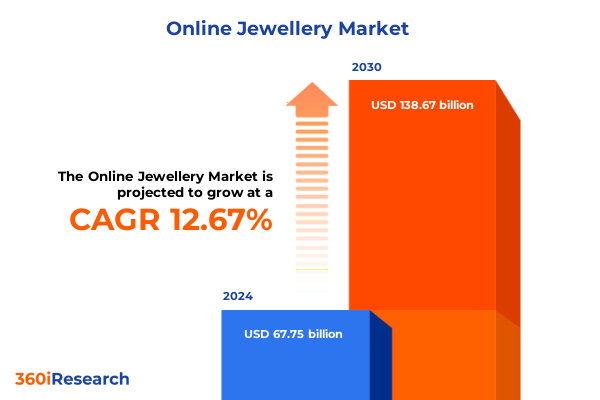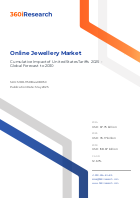The Online Jewellery Market size was estimated at USD 67.75 billion in 2024 and expected to reach USD 76.17 billion in 2025, at a CAGR 12.67% to reach USD 138.67 billion by 2030.

Introduction to the Online Jewellery Landscape
The online jewellery market stands at a pivotal moment, shaped by evolving consumer expectations, digital innovations and shifting trade policies. While traditional brick-and-mortar stores continue to serve a loyal clientele, e-commerce platforms and brand websites have established themselves as critical conduits for both emerging artisans and heritage houses. Customers now demand transparency in sourcing, personalized experiences and seamless omnichannel journeys. In response, market participants are integrating augmented reality try-on tools, blockchain-backed provenance tracking and AI-driven customization engines to captivate discerning shoppers. Moreover, the pandemic accelerated consumer adoption of digital channels, prompting companies to recalibrate their strategies and enhance online engagement.
Against this backdrop of rapid technological adoption and changing buyer behavior, understanding the forces at play is essential for stakeholders seeking to navigate complexities and capitalize on growth opportunities. This report delves into the transformative shifts reshaping the landscape, the ramifications of new trade measures, critical segmentation dynamics, regional nuances and competitive intelligence on leading players. Through rigorous analysis, it equips decision-makers with a comprehensive perspective and prescriptive guidance to strengthen their market positioning and drive sustainable advantage.
Transformative Shifts Reshaping the Online Jewellery Market
The online jewellery sector is undergoing a fundamental reconfiguration driven by three overarching shifts. First, the convergence of digital and physical experiences has blurred traditional boundaries. Interactive virtual showrooms and live video consultations enable consumers to engage with pieces in real time, diminishing the distinction between shopping at home and visiting a boutique. Second, sustainability and ethical sourcing have transitioned from niche concerns to mainstream expectations. Suppliers are increasingly required to demonstrate responsible mining practices and equitable labor standards through transparent certification systems.
Finally, personalization has emerged as a key differentiator. Consumers expect tailored product recommendations, custom engraving options and modular designs that reflect their individual story. Advanced analytics and machine learning models now power hyper-targeted marketing campaigns and dynamic pricing strategies. Taken together, these transformative forces compel established brands and new entrants alike to embrace agility, invest in digital innovation and forge deeper emotional connections with their audience. As the sector evolves, companies that anticipate consumer desires and leverage cutting-edge technology will establish leadership in this highly competitive environment.
Cumulative Impact of United States Tariffs in 2025
Trade tensions and revised tariff schedules have introduced a new set of challenges for online jewellery retailers. In 2025, the United States implemented adjusted duties on certain imported precious metals and gemstone pieces, elevating costs for companies that rely on cross-border supply chains. These elevated tariffs affect everything from silver pendants sourced from abroad to diamond-encrusted rings crafted in international ateliers. As a result, many online merchants have encountered margin pressures, prompting them to reassess vendor contracts, renegotiate shipping terms and explore alternative sourcing locations.
In some cases, importers have shifted production to jurisdictions exempt from higher duties, while others have absorbed incremental costs to maintain price competitiveness. The knock-on effect has included realigned inventory strategies, with businesses prioritizing domestic production for high-value items and imported collections for entry-level offerings. Consumer perceptions have also been influenced; shoppers are increasingly attuned to origin labels and associate local craftsmanship with enhanced authenticity. In navigating this complex terrain, successful players are those that balance cost optimization with transparent messaging, ensuring that tariff-related pricing adjustments resonate with consumer priorities rather than erode brand trust.
Key Insights from Market Segmentation
A nuanced view of consumer demand emerges when examining core product categories such as bracelets, brooches, earrings, necklaces and rings. Each accessory type appeals to distinct purchase occasions and demographic segments, influencing both design focus and marketing approaches. Similarly, material composition plays a pivotal role: gemstone offerings-spanning diamonds, emeralds, rubies and sapphires-tend to attract high-luxury buyers, whereas variations in gold tiers like rose gold, white gold and yellow gold serve as accessible entry points for frequent gift purchases. Platinum pieces occupy a premium niche, prized for durability and rarity, while silver remains the go-to for fashion-forward yet cost-sensitive consumers.
Online channels further differentiate consumer journeys, with brand websites providing curated storytelling experiences and e-commerce platforms offering broad product assortments and competitive pricing. Sales through a brand’s own digital storefront enable full control over brand narrative, whereas third-party marketplaces drive volume and exposure. Finally, gender segmentation-encompassing female, male and unisex collections-shapes design language, with many firms expanding beyond traditional women’s jewellery to capture the growing male and unisex markets. Together, these segmentation insights guide product development roadmaps, promotional mix allocations and digital merchandising strategies to align offerings with the nuanced expectations of each target cohort.
This comprehensive research report categorizes the Online Jewellery market into clearly defined segments, providing a detailed analysis of emerging trends and precise revenue forecasts to support strategic decision-making.
- Product Type
- Material Composition
- Sales Channel
- Gender
Key Regional Insights in Online Jewellery
Regional distinctions in consumer preferences and regulatory landscapes significantly influence performance across the Americas, Europe/Middle East/Africa and Asia-Pacific. In the Americas, established brand loyalty and high smartphone penetration drive robust online sales, with shoppers favoring personalized gold and diamond pieces. Meanwhile, Europe, the Middle East and Africa display heterogeneity: Western Europe responds favorably to sustainable jewellery narratives, the Middle East values artisanal craftsmanship in platinum and gemstone pieces, and select African markets show emerging interest in silver-based designs.
The Asia-Pacific region, by contrast, represents a mosaic of fast-growing digital economies. In markets like China and India, domestic production ecosystems enable competitive pricing for gold alloys, while consumers in Australia and Japan prioritize minimalistic designs and brand heritage. Payment preferences also vary: digital wallets dominate in Southeast Asia, credit card usage is prevalent in North America, and bank transfers remain popular in parts of Europe. Understanding these regional nuances empowers companies to tailor their product assortments, pricing policies and marketing narratives for maximum resonance across diverse consumer bases.
This comprehensive research report examines key regions that drive the evolution of the Online Jewellery market, offering deep insights into regional trends, growth factors, and industry developments that are influencing market performance.
- Americas
- Asia-Pacific
- Europe, Middle East & Africa
Key Company Developments and Strategies
Leading jewellery businesses are pursuing a range of strategies to secure market share and foster innovation. Among them, Angara Jewels Private Limited and GIVA Jewellery illustrate the success of direct-to-consumer models that emphasize custom craftsmanship and digital first-touch experiences. Blue Nile Inc., James Allen and Titan Company Limited leverage scalable e-commerce infrastructures to offer extensive assortments complemented by virtual try-on solutions. Heritage houses like Bulgari S.p.a., Cartier S.A. and Tiffany & Co. maintain brand prestige through limited-edition collections and immersive storytelling on their proprietary websites.
Meanwhile, emerging disruptors such as Brilliant Earth, LLC and Graff Diamonds Limited prioritize ethical sourcing by partnering with certified mines and investing in traceability platforms. Signet Jewelers and Helzberg Diamonds integrate omnichannel capabilities, blending in-store personalization with online configurators. Niche players like Etsy, Inc. and Le Vian Style Bar capitalize on handcrafted uniqueness to appeal to diverse consumer tastes. Collectively, these companies underscore the importance of strategic differentiation, whether through supply chain transparency, digital engagement or hybrid retail ecosystems, in sustaining competitive advantage.
This comprehensive research report delivers an in-depth overview of the principal market players in the Online Jewellery market, evaluating their market share, strategic initiatives, and competitive positioning to illuminate the factors shaping the competitive landscape.
- Angara Jewels Private Limited
- Blue Nile Inc.
- Brilliant Earth, LLC
- Bulgari S.p.a.
- Cartier S.A.
- Chopard Group
- Chow Tai Fook Jewellery Company Limited
- David Yurman Enterprises LLC
- De Beers Group
- Etsy, Inc.
- GIVA Jewellery
- Graff Diamonds Limited
- Harry Winston, Inc.
- Helzberg Diamonds a Berkshire Hathaway Company
- James Allen
- Kalyan Jewellers
- Le Vian Style Bar
- Malabar Gold And Diamonds Limited
- Mikimoto (America) Co., Ltd.
- PANDORA EComm, LLC
- PC Jeweller
- Signet Jewelers
- Swarovski Crystal Online AG
- Tiffany & Co.
- Titan Company Limited
Actionable Recommendations for Industry Leaders
Industry leaders must adopt a multi-pronged approach to thrive in an increasingly digital and competitive environment. First, supply chain resilience should be elevated to a strategic priority. This entails diversifying sourcing partnerships across tariff-advantaged regions and forging strategic alliances with local artisans to mitigate trade-related cost fluctuations. Next, investment in immersive digital experiences-augmented reality try-ons, 3D product visualization and AI-driven fit recommendations-will enhance consumer confidence and reduce return rates.
Moreover, brands should deepen their commitment to sustainability by securing third-party certifications, publishing annual impact reports and leveraging blockchain or similar technologies for transparent provenance tracking. On the marketing front, dynamic segmentation strategies that integrate real-time data on browsing behavior, purchase history and social sentiment will bolster conversion rates and foster loyalty. Finally, agile organizational structures-characterized by cross-functional collaboration between design, technology and marketing teams-will accelerate innovation cycles and ensure rapid response to evolving consumer trends. By executing these recommendations, companies can fortify their market leadership and deliver meaningful value to both stakeholders and end users.
Explore AI-driven insights for the Online Jewellery market with ResearchAI on our online platform, providing deeper, data-backed market analysis.
Ask ResearchAI anything
World's First Innovative Al for Market Research
Conclusion
The online jewellery market continues to evolve at an unprecedented pace, driven by technological innovation, shifting consumer values and complex trade dynamics. Through a detailed examination of digital transformation trends, the 2025 United States tariff adjustments, segmentation nuances, regional variations and competitive positioning, this report has illuminated the critical factors shaping success. Companies that proactively address supply chain vulnerabilities, embrace immersive digital engagement, uphold transparent sustainability practices and harness advanced analytics will be well-positioned to capture growth and build lasting customer loyalty.
As the competitive landscape grows more intricate, the most successful players will blend heritage craftsmanship with modern retail technology, balancing authenticity with convenience. By maintaining an unwavering focus on consumer expectations and fostering a culture of agility, industry leaders can unlock new avenues of differentiation and reinforce their market standing in the years ahead.
This section provides a structured overview of the report, outlining key chapters and topics covered for easy reference in our Online Jewellery market comprehensive research report.
- Preface
- Research Methodology
- Executive Summary
- Market Overview
- Market Dynamics
- Market Insights
- Cumulative Impact of United States Tariffs 2025
- Online Jewellery Market, by Product Type
- Online Jewellery Market, by Material Composition
- Online Jewellery Market, by Sales Channel
- Online Jewellery Market, by Gender
- Americas Online Jewellery Market
- Asia-Pacific Online Jewellery Market
- Europe, Middle East & Africa Online Jewellery Market
- Competitive Landscape
- ResearchAI
- ResearchStatistics
- ResearchContacts
- ResearchArticles
- Appendix
- List of Figures [Total: 24]
- List of Tables [Total: 284 ]
Get Your Market Research Report Today with Expert Assistance
For a comprehensive deep dive into actionable insights and data-driven strategies tailored to your business needs, reach out to Ketan Rohom (Associate Director, Sales & Marketing). Benefit from expert guidance to navigate the evolving online jewellery market and secure a competitive edge with the full market research report.

- How big is the Online Jewellery Market?
- What is the Online Jewellery Market growth?
- When do I get the report?
- In what format does this report get delivered to me?
- How long has 360iResearch been around?
- What if I have a question about your reports?
- Can I share this report with my team?
- Can I use your research in my presentation?




